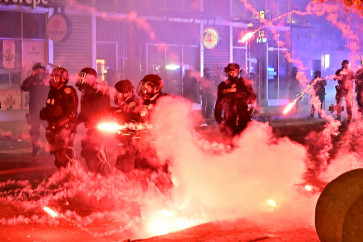Popular Reads
Top Results
Can't find what you're looking for?
View all search resultsPopular Reads
Top Results
Can't find what you're looking for?
View all search resultsVertical caving: Underground excitement
The crescent moon had slipped through the night as we entered the village
Change text size
Gift Premium Articles
to Anyone

T
he crescent moon had slipped through the night as we entered the village. The darkness of the night made us disoriented as the surroundings looked familiar. As we got lost and missed the signboard at the entrance, a motorcycle guided us in and we slowly drove on the village’s bumpy road for 15 minutes.
Beautiful ray of lights in Grubug.
Finally, we got to our destination and we immediately sat down on the floor of a terrace (pendopo), trying to give our exhausted bodies some rest and get some sleep before the next day.
A beautiful sunrise accompanied us, rising above the shade of teakwood trees surrounding Jomblang village, about 17 kilometers from Wonosari. Located about 40 km southeast of Yogyakarta, Wonosari is the capital of Gunung Kidul regency.
The area where Jomblang cave is located is not famous. But among cave enthusiasts, nature trekkers and backpackers, it is has become well known for its beauty.
As a natural cave standing on limestone, Jomblang provides a quite long line for vertical caving which is exciting for most people. Jomblang also connects to Grubug cave by a horizontal path.
Most of the caves of the Gunung Kidul high terrain are comprised of limestone, which is by nature soluble and has created hundreds of beautiful caves inside. The limestone’s porousness has also left huge natural water deposits underneath, which flow as underground rivers.
After we warmed up, our guide showed us the climbing tools and the right way to use them. As a rookie, I didn’t recognize any of those tools except for the carabiner, helmet and harness.
After 10 minutes, I realized that climbing tools were divided into two major parts, descending and ascending. For descending, we will need tools such as hip harnesses, jammers and, the most important thing, descender stops. Whereas for ascending, there are some extra tools, such as chest harnesses, foot loops and ascenders.
I didn’t force my brain to memorize all of this but instead I tried to understand how they worked and how to use them correctly.
We had our trial session by applying the descending and ascending tools on a tree before going into the real battle field.
There we were, standing at the edge of Jomblang’s mouth at 10:15 in the morning. There were two vertical lines available, the one on the north side and another line approximately 100 meters across
the mouth.
The first line is 63 meters deep and the last line only 15 meters, so that they called it a VIP line. They called it VIP lines of course with the reason that this is in fact the easiest way to reach the bottom.
As a beginner, we actually had to take the VIP line but the guide challenged the six of us to go down through the 63 meter line and we accepted it.
The first participant went down, and it took almost 20 minutes for her to reach the bottom. Considering the preparation needed and traveling time to the bottom, I and a friend decided to take the VIP line to save some time.
First we had to get through a inclined wall (inclined at 30 to 80 degrees!) by rappelling. After approximately 20 meters, then we had to go through a 15 meter vertical cliff using the single rope technique. It was not quite hard, except for a ‘stiff thumb’ feel on my left hand.
The rope we used had already expanded due to long use, therefore inhibiting the descender stop from working well. Most of the time I had to press hard with my thumb just to make the rope loose and move my body downwards.
Since the rope was not a good fit with the descender, I had a jerky trip down.
It was bumpy and sometimes I got stuck for a moment in the air with an adrenaline rush.
Although the rope’s capacity was 120 kilograms, I had to learn to be calm to let my life depend on a piece of a rope. It was not easy for me. I never really trusted mechanical tools anyway.
A similar problem was also faced by others: Their descender stops became hot and forced them to let the tool cool by resting in the air for a couple minutes. “I should have had a video camera on my helmet to tape the remarkable view from 40 meters up there”, said one of the participants.
At 12:30 p.m. we all managed to reach the bottom of Jomblang. It was quite surprising though to see that the cave bottom looked like a tropical forest. High hard trees and bushes were growing everywhere atop brownish soil.
No wonder, because the area was wide open to sunshine. We walked towards a large chamber on the north side. The size of this chamber is enormous, approximately 80 meters high and 50 meters wide. We walked on the slippery and humid soil inside, following on a trail of artificial stones.
I thought the trail connecting Jomblang and Grubug was long, but it turned out that it was only about 150 meters. Later, I was approaching the mouth of Grubug.
There went my camera’s tripod, two flashes, one wireless trigger and two receivers since I could not get any remarkable objects to document around the path.
But then “Wow..!” I could not keep my mouth shut when we saw some of the most beautiful underground scenery of our lives. When we entered Grubug, we saw beautiful rays of light entering from the top of cave.
I was told before that between 11 a.m. and 1 p.m., the sun shines to the bottom of the Grubug, creating a magnificent view. For me this was really different.
We didn’t get merely sunlight but a lot of light instead! It was 12:40 p.m. when sun was high and its rays shone through the leaves of the tress above, dividing it into shiny rays of light. I grabbed a camera and then took a lot of photos, realizing that that view would only last for 15 minutes!
The lights then merged into a single big diffuse light.
Grubug cave consists of a bed of limestone of the calcarenite type. It is not common for underground caves to develop in this kind of limestone since the hardness, solubility and other physical properties of the rocks differed from one bedding to another. That’s why I didn’t notice a lot of stalactites and stalagmites, perhaps due to the material heterogeneity and lack of underwater drops.
Usually, underground caves will develop inside limestone that comes from reefs since they have similarities in physical properties. In the middle of Grubug, I noticed two large boulders.
Those boulders developed from the soluble limestone from rainwater, creating white bone-colored calcite minerals. Those minerals were transported and underwent a lithification process, creating a wavy structure in the surface and pillar structures on the side.
Right above the stones, there was an 80 meter descending line. Anyone who likes challenges should try this Grubug descending line, which is only 300 meters away from Jomblang. Below, to the north, there was an underground river.
In the dry season when the water table is low, people can track this river by rafting from the River Suci and end up here. The next part is impossible to track since the cave is so small although the water runs until it reaches the Java Sea to the south.
We were started to go back at 1:30 p.m., heading to the VIP line for a heavy challenge, ascending. The first four of us managed to go up successfully. During my turn, after ascending for 6 meters, I got cramp. It was not as easy as I thought although I already trained myself.
I had to be rescued. Although it was quite embarrassing, I fully enjoyed the excitement of Jomblang and Grubug caving.
It’s a wonderful thing that you should try at least once in a lifetime!
— Photos by Heru Hendarto
Where to Stay :
Stay either in Yogyakarta or Wonosari and leave early in the morning or spend the night at the Jomblang rest area. There are several nice cottages, equipped with electricity and water. The mouth of Jomblang River is only 150 meters away. A cheaper option is to stay at the home of the Jetis Wetan village chief, Pak Brewok.
How to Get There :
Jomblang cave is in Jetis village,
Semanu, Wonosari, Yogyakarta. The only way to reach this place is using land transportation from Yogyakarta. Traveling southeast for 57 km, we reach Jomblang in 1.5 hour. You can also rent a taxi or a car. Using a motorcycle will be a lovely option since the scenery up there also beautiful.









